One of the most famous bridges in the world
Introduction
Brooklyn Bridge is located in New York City between Manhattan and Brooklyn, connecting the city's two most famous districts. It's one of the American city's most famous symbols, and at the same time is one of the most famous, most visited and most photographed bridges in the world.
Facts about the Brooklyn Bridge
The Brooklyn Bridge was built between 1870 and 1883, and upon its inauguration was the largest and longest hanging bridge in the world for twenty years: meaning the first steel cable suspension bridge. Its length is over 1, 800 metres (1. 8 kilometres) and its width 26 metres. As you can see, it's not solely a symbol of New York, but also a record-breaking bridge, innovative for its time and an architectural marvel in the world of bridges.
Brooklyn Bridge is Neo Gothic in style. The materials used for its construction were cement, limestone and granite, in addition to its steel cables.
Another distinguishing feature of the bridge are its two arches united by the two towers at each end; every tower appears to be divided then into two other towers, with an arch for each. I don't see them as two towers, but instead as four.
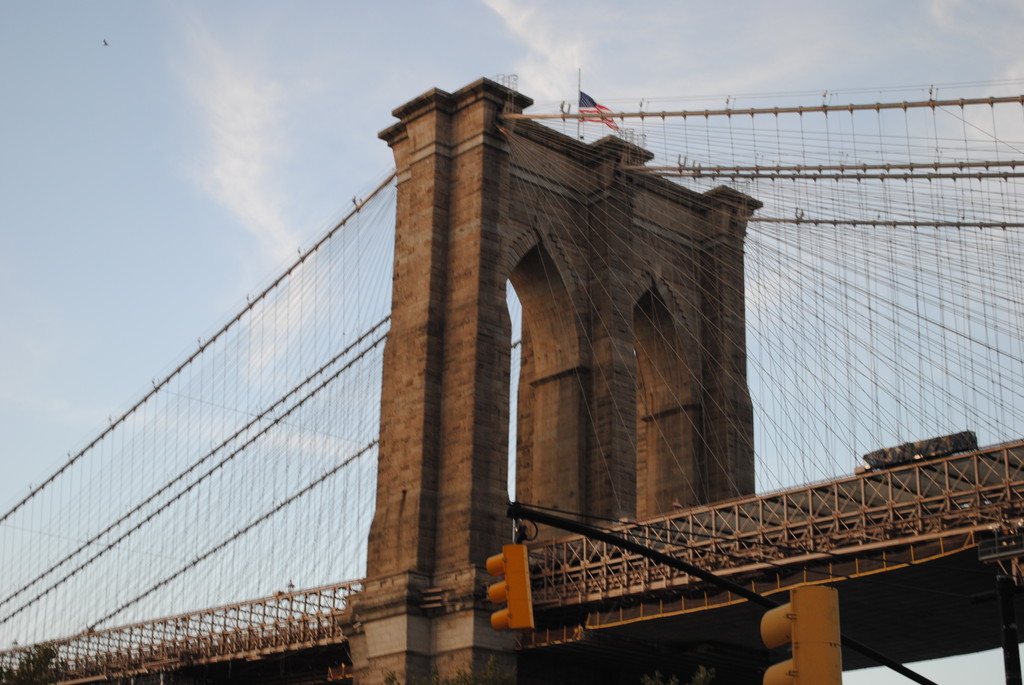
The decision to construct the bridge was made due to the difficulty in getting from Manhattan to Brooklyn by boat when the river had frozen. Beforehand, the crossing of people hadn't been as important, but today the bridge is frequently used.
Brooklyn Bridge has six vehicle lanes, which seems like madness to me - just imagine how large it is! This is necessary however due to the immense amount of traffic that there is between Brooklyn and Manhattan, which leads to lots of traffic jams despite the six lanes of traffic. There is also a pavement for pedestrians and bicycles. In my opinion, using your bike on the bridge is quite a dangerous thing to do, though there are people who just carry it on their backs over the bridge until they reach the other side!
In addition to the large amount of cars and tourists, you can also find street souvenir sellers on Brooklyn Bridge, though I'm not sure if this is entirely legal. I bought a key ring there for a dollar, and it wasn't bad, while if you buy the same key ring on Times Square it'll cost you at least three or four dollars.
Personal experience and advice
I've crossed the bridge by day and by night. On the one hand, it's a good idea to cross the bridge when the sun is still up so that you can fully appreciate the bridge's design, its colours, materials, the amount of cables it has, and the immense and fantastic views towards Brooklyn and Manhattan, and towards Manhattan Bridge.
I also recommend crossing the bridge to get to DUMBO to see the sunset. DUMBO is on the shores of the river in Brooklyn, and it's there that you'll be able to one of the classic photographs of New York and enjoy a large panoramic view of Brooklyn Bridge (for more information, read my other article about DUMBO).
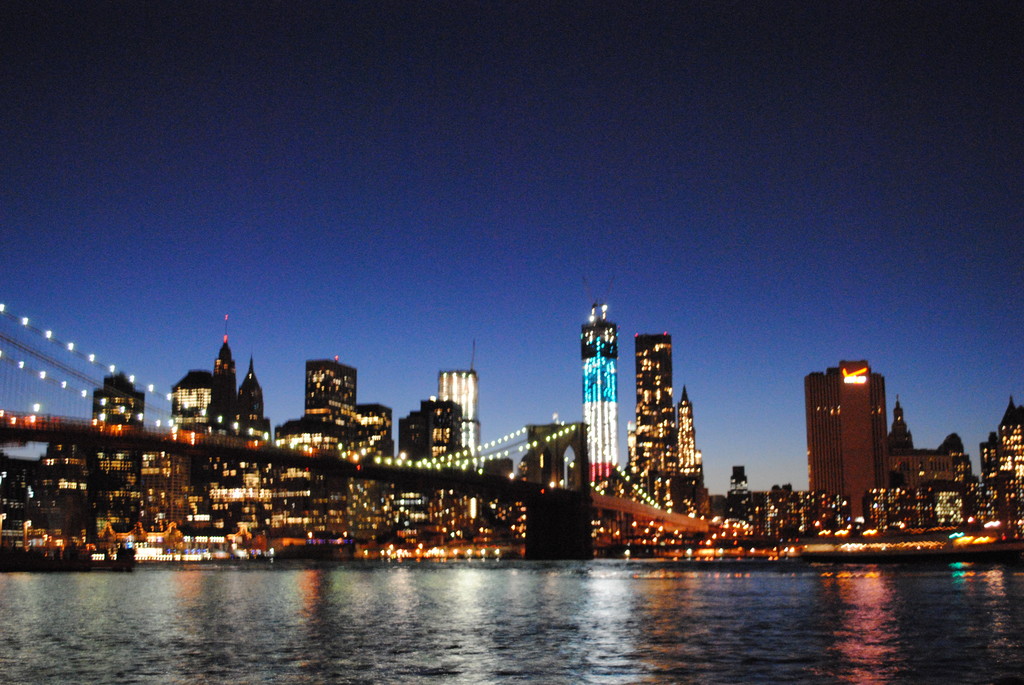
It's also quite cool to cross the bridge at night or while the sun is setting, but I recommend doing so in the direction of Manhattan, since you can see from the bridge how all the lights are turned on in the city that never sleeps, and all the beauty this creates. They also light up Brooklyn Bridge itself to accentuate its silhouette. The main disadvantage to crossing the bridge at night is that it's almost two kilometres long, and after a day of walking around the city that might be a bit much for your tired feet to manage. If you've still got energy left however, then go for it!
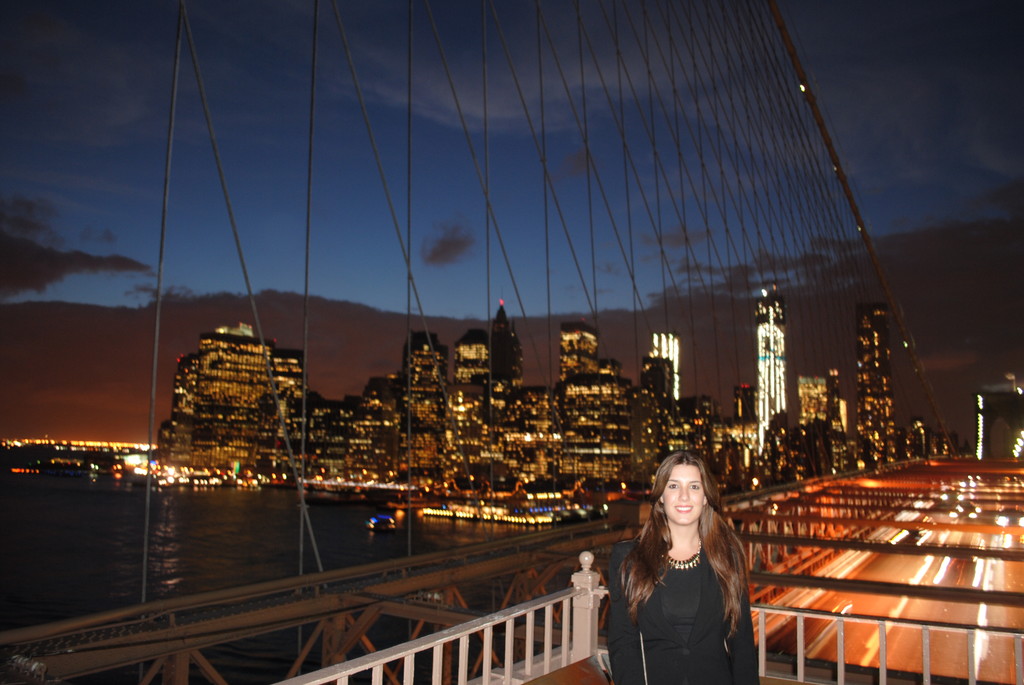
Some advice I'd give you for crossing the bridge on foot is to take water with you in your bag, along with a snack, and definitely to go to the bathroom beforehand! Speaking from experience, you'll start to need the loo before you've even gotten halfway across the bridge, and imagine how this affects your ability to enjoy the great views.
Something which will surprise you, and which at first I didn't like, is the amount of cables on the bridge. At some points, there are so many that it's impossible for you to enjoy the views properly, and you feel like you're not on a bridge at all. In the end though, I saw their charm.
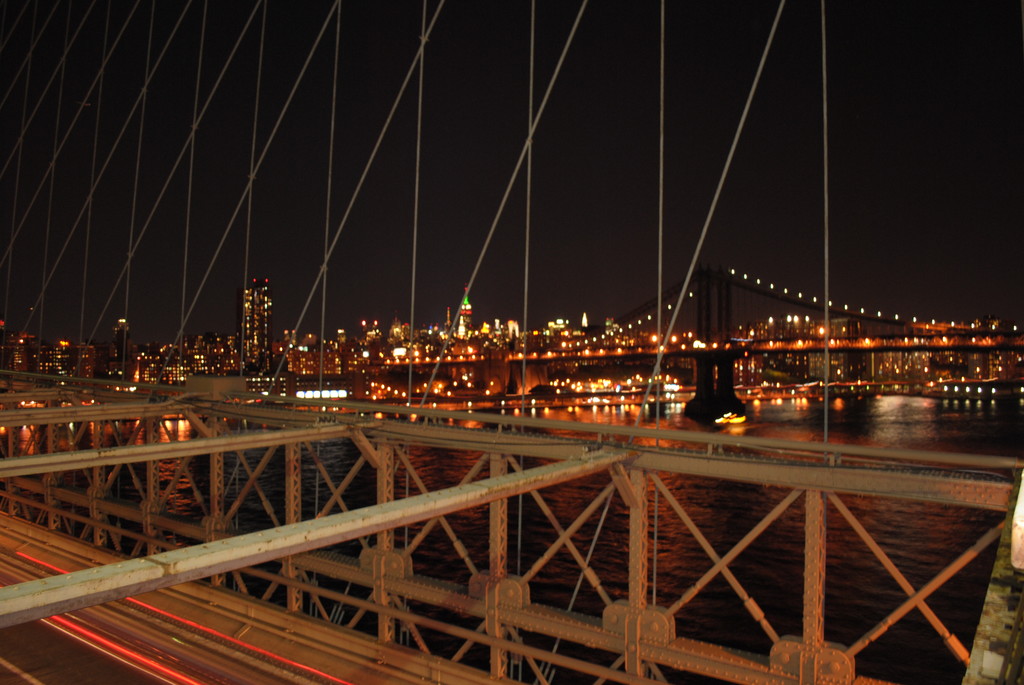
Strange facts about the bridge
A tragedy happened on the bridge when twelve people were crushed to death in a stampede caused by rumours that the bridge was collapsing. This occurred shortly after the bridge was constructed, which perhaps makes more sense in context since the bridge was innovative for its time and its size alone gave cause for concern.
Another thing that I once read about the bridge is that several people have tried to jump from the bridge for a dare or to commit suicide, and some have even survived.
Another interesting aspect of the Brooklyn Bridge is its frequent appearance in films (Godizilla, Gans of New York, Kate&Leopold... ), television series (CSI New York, Gossip Girl... ), comics (Spiderman), and videogames (SimCity3000 and SimCity4). It has also been the setting for several books. So, when you visit or cross Brooklyn Bridge, you'll find it quite familiar.

How to get to Brooklyn Bridge
The best way to get to Brooklyn Bridge is via metro or bus. With the metro you have two options: get off at the Manhattan Bridge stop or the Brooklyn Bridge stop. If you want to go to Manhattan Bridge, you'll need to get off at the stop named 'Brooklyn Bridge City Hall' (on lines 4, 5 and 6); and if you want to go to Brooklyn Bridge directly, the stop you need is called 'High St' and lines A and C run through it (to get to DUMBO, you get off at the same stop). The bus lines running through here are the M9, the M15, the M22 and the M103.
And if you're interested in going to New York, have a look at this complete guide to New York at Christmas: the most wonderful time of the year!
Photo gallery
Content available in other languages
Brooklyn Bridge

Of all the advances made in engineering in the 1800s, the Brooklyn Bridge is highlighted as perhaps one of the most famous and most notable. It took more than a decade to build, it cost its designer his life, and it was constantly criticised by skeptics who predicted that the whole structure was going to collapse into the East River.
John Roebling, a German immigrant, did not invent the suspension bridge, but his working bridges in the US made him the most prominent bridge builder in the United States in the mid-1800s. His bridges over the Rivers Allegheny in Pittsburgh (completed in 1860) and Ohio in Cincinnati (completed in 1867) were considered to be great achievements. Notably, Roebling began to dream of traversing the East River of New York and Brooklyn (which were two separate cities back then) in 1857, when he drew designs for enormous towers that could cover the suspension cables. The Civil War over the bridge put all plans in limbo, but, in 1867, the New York State Legislature hired a company to build a bridge over the East River. And, Roebling was chosen as head engineer.
In the summer of 1869, a tragedy occurred. John Roebling seriously injured his foot in an accident while he was inspecting the area where the Brooklyn Tower was going to be built. Not much after, he died of tetanus, and his son, Washington Roebling, who was a distinguished official of the Union of the Civil War, became the chief engineer of the bridge project.
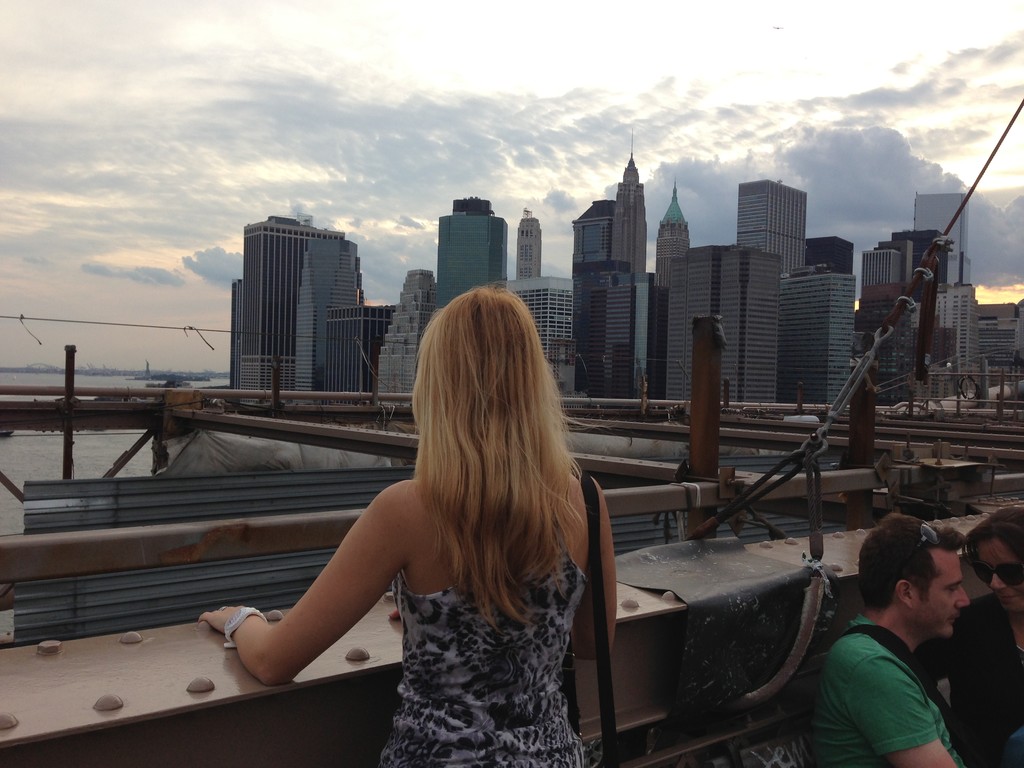
Talking about ways to save the East River already began in 1800, when big bridges were essentially just dreams. The advantages of having a convenient link between the two growing cities of New York and Brooklyn were obvious. But the idea was thought to be impossible due to the width of the waterway, which, in spite of its name, was not really a river. The East River, in reality, is a salt water estuary, with a tendency to suffer from turbulent and challenging conditions. What further complicated the matter was the fact that the East River was one of the busiest waterways in the world, with hundreds of boats of all sizes navigating its waters at any one time. Any bridge above the water would have to allow ships to pass underneath it, which meant that the only solution was to have a very high suspension bridge. In effect, this meant that the bridge has to be the biggest bridge ever built, almost double the length of the famous Menai Suspension Bridge, which was announced as the one of the biggest ever suspension bridges when it was inaugurated in 1826.
Perhaps the biggest innovation dictated by John Roebling was the use of steel in the construction of the bridge. The first hanging bridges had been built with iron, steel, but the Brooklyn Bridge would be much stronger. Digging the foundation of huge towers of the stone bridge, crates and huge, bottomless wooden boxes were sunk into the river. The compressed air was pumped into them, and the men inside them would be digging away at the sand and rocks at the bottom of the river. The stone towers were built on top of the crates, which sunk deeper to the river bottom. Working in the East River was extremely difficult, and the men who did it, called "sand pigs", took huge risks. Washington Roebling, who went into one of the crates to supervise the work, was involved in an accident, leaving him to remain in his house in Brooklyn Heights for the foreseeable future. His wife, Emily, who trained as an engineer, would take instructions every day to the bridge work site. Thus, feeding the rumours that a woman was secretly the chief engineer of the bridge.
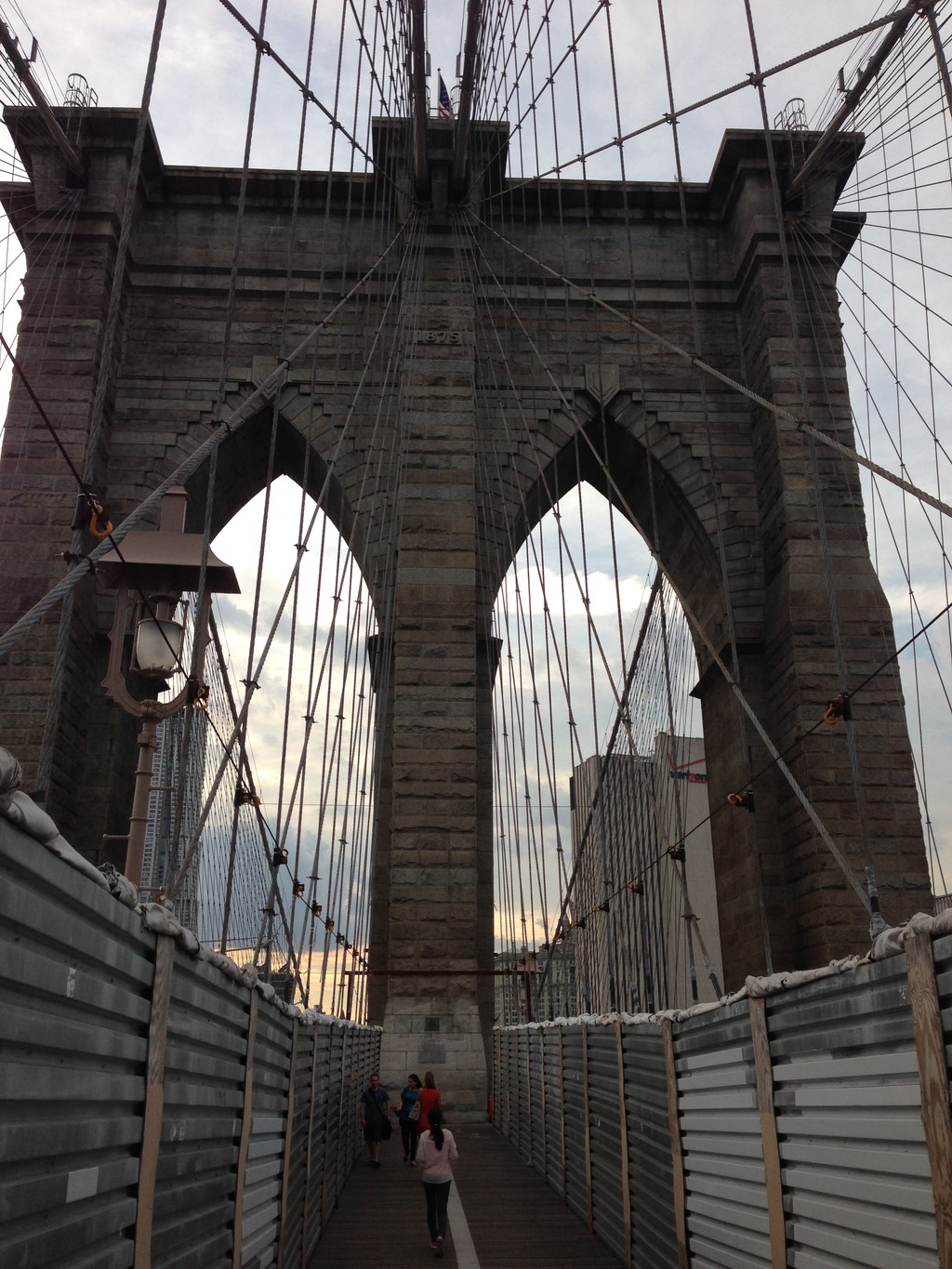
After the crates had sunk to the bottom of the river, they were filled with concrete, and the construction on the stone towers continued above. When the towers reached their maximum height, 278 metres above the high water, they began to work on the four enormous cables that would support the road. Spinning the cables between the towers began in the summer of 1877, and it was completed one year and four months later. But, they would need almost another five years to suspend the road from the cables and have the bridge ready for traffic. The bridge was always controversial, and not only because the skeptics thought that Roebling's design was unsafe. There were stories of political payouts and corruption, rumours of carpet bags full of money lent to people like Jefe Tweed, the leader of the political organisation known as Tammany Hall. In one famous case, a steel cable manufacturer sold low quality material to the bridge company. The culpable one hiding in the shadows, J. Lloyd Haigh, escaped justice. But the bad wire sold to the company is still on the bridge, as it could not be removed once the wires had been worked on. Washington Roebling compensated its presence, assuring that the lesser quality material would not affect the strength of the bridge. When the bridge was completed in 1883, its construction had cost around $15 million, more than double of John Roebling's original estimate. And while no official figures were kept with regards to the number of men who died during the construction of the bridge, it was reasonably estimated that around 20 to 30 men perished in a variety of accidents.
The grand opening of the bridge was celebrated on 24 May 1883. Some Irish residents of New York were offended as the day also happened to be Queen Victoria's birthday, but the majority of the city still celebrated. President Arthur came to the city of New York for the event and brought a group of dignitaries who walked across the bridge. Military bands played, and Brooklyn Navy Yard cannons sounded. Speakers praised the bridge, calling it "a wonder of science" and applauded its anticipated contribution to US trade. The bridge became a instant symbol in the modern age. More than 125 years after its completion, the bridge still acts as vital route every day for commuters in New York. And whereas the road structure has changed in line with changes in road traffic, the pedestrian walkway continues to be a popular attraction among parents with strollers, onlookers and tourists alike.

Photo gallery
Content available in other languages
- Español: Brooklyn Bridge
Rate and comment about this place!
Do you know Brooklyn Bridge? Share your opinion about this place.

























